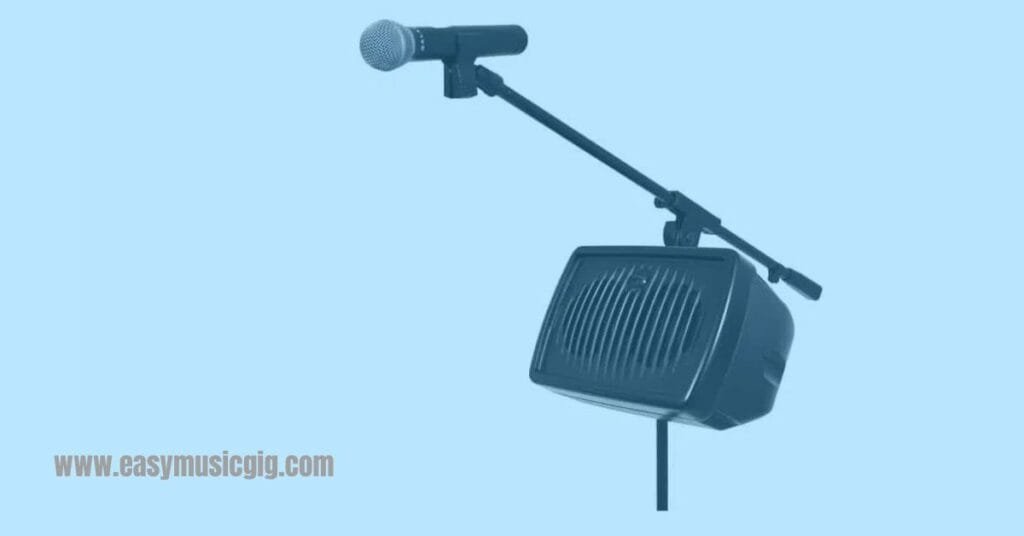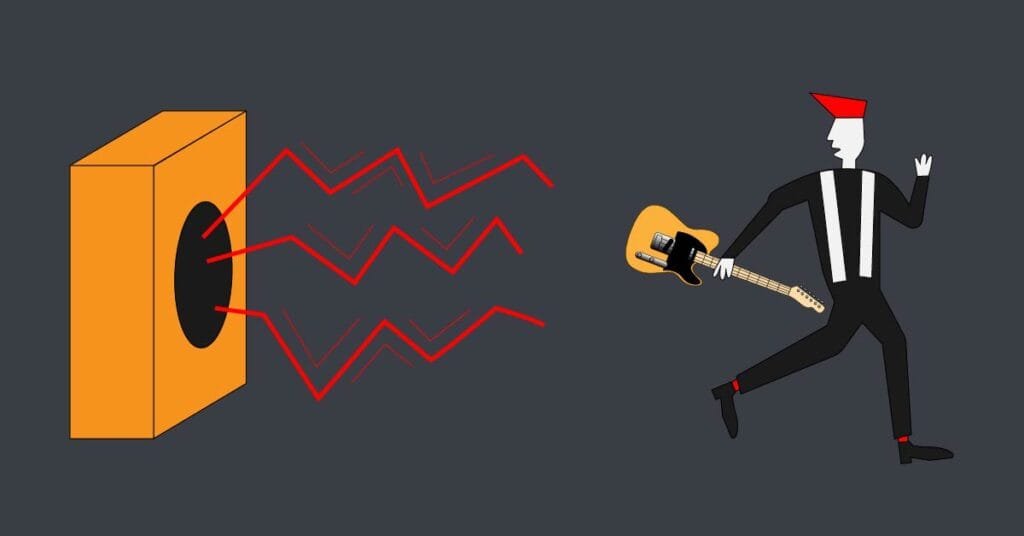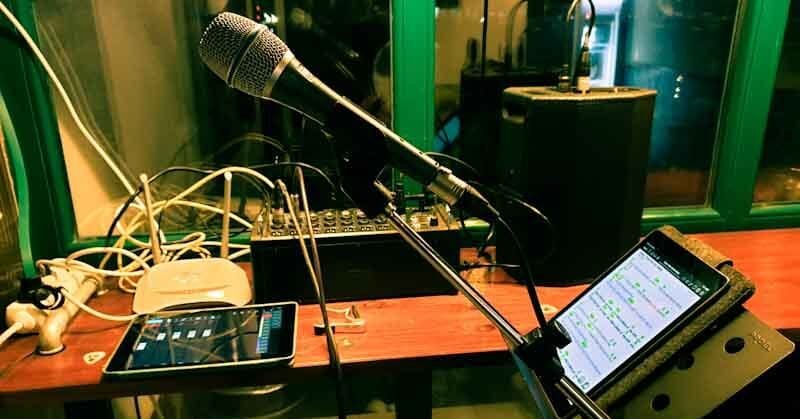Should you sit or stand when playing guitar or bass?
Many guitar and bass players wonder whether it’s better to stand or sit when playing their instrument live. Of course, this goes for gigs where you have the freedom to decide which option is best for you. This dilemma is usually associated with small to mid-sized venues, not the big shows you play at sports arenas or stadiums.
This seems like a simple choice, but the position in which you play can significantly affect your comfort, tone, and overall performance. In this guide, we’ll explore both approaches to help you choose the best way to play your instrument on your next gig. We will also mention the best playing positions for practicing.
- Sitting vs standing – What are the main differences?
- Benefits of sitting while playing guitar
- Drawbacks of sitting while playing guitar
- Benefits of standing while playing guitar
- Drawbacks of standing while playing guitar
- Tips for both positions
- More tips from a pro
- Playing with back or shoulder pain
- Final thoughts – Which is best for you?
Sitting vs standing – What are the main differences?
It seems like an easy decision: sit while practicing and stand during gigs, but it’s not that simple. Let’s explain.
When you play sitting, your guitar is supported by your leg, as well as your arms and neck through your guitar strap, and weight isn’t a big issue. But when you stand with your guitar, the whole weight is supported by your neck and back, and the fretboard isn’t in the same visual and physical distance as when seated.
Factors like strap height and the guitar’s neck angle are very different when sitting or standing with your instrument. Every guitarist has experienced this: you practiced all the songs you’re going to play at one of your first gigs, and when you stand up while playing, it seems like you haven’t learned a thing; everything is so different.
In reality, you should be able to perform at the same level of quality in both positions. And this is something where practicing in both positions helps.
Benefits of sitting while playing guitar
This is the way the guitar was meant to be played. Classical guitar players are never seen playing in the standing position. Many jazz players also choose the sitting position. Why is this?
1. Better access to the fretboard
The classical guitar is played in the sitting position with the guitar’s body sitting on your left thigh. This position gives us the best access to the fretboard and places the guitar at an optimal height.

2. Comfort
It is more comfortable to play your guitar while sitting than standing. Comfort becomes an important issue when learning new things and practicing old stuff over and over again. If you practice for several hours standing, you will get tired.
3. Studio work
Think of studio work as practicing, but you’re not expected to make a lot of mistakes. When we look at videos of The Beatles or The Rolling Stones in the studio, we almost always see that they are sitting.

These are the main physical benefits of sitting when playing the guitar, but not all situations allow us to sit while performing. Other factors also contribute to the whole show, not just the physical ones.
Drawbacks of sitting while playing guitar
- If you practice only sitting, you will not be prepared for live shows
- In a live scenario, the energy, visibility, and connection with your audience are limited
- Pedalboard and amplifier access can be limited
Benefits of standing while playing guitar
Everybody expects to see guitar and bass players standing while performing live. An exception is classical guitar players and some jazz-oriented styles of music, or specialized shows like the MTV Unplugged series. Here are some of the most important benefits of playing standing.
1. Stage performance
Stage presence is all about interaction with your bandmates and your audience. This is done much more easily while standing and being able to freely move around during live performances. But to achieve a technique that is needed for playing while standing, players must practice their materials the same way, standing.
2. Improved access to your instrument
When you play standing, it is easier to change the angle of your guitar’s neck (fretboard) for different song parts or whole songs. Sometimes we need to have easier access to the first frets, which can be done by tilting the guitar upwards. This can’t be done while seated.
Certain musicians prefer to hold their guitar or bass extremely low (think punk and rock music!). Only a standing position allows this posture.

3. Practicality
Changing instruments during a show is common. It would be very difficult to do so while sitting, even if a band’s crew member brings your new guitar for you.
The ability to walk around and change settings on your amp is sometimes crucial due to varying sound acoustics from venue to venue. The same goes for your pedals, MIDI controller, and bluetooth page turner; it’s much easier to step on all those pedal switches when standing.
4. Performance preparation
If you are going to be performing standing, you have to get used to it. The only way to prepare your muscles and mindset for gigs is to mimic the whole thing, and that includes standing while repeating the sets.
When you practice standing, you will be prepared for the concert. I have experienced many surprises during concerts where I haven’t practiced in the standing position at home.
Drawbacks of standing while playing guitar
- If playing long sets, getting tired is inevitable
- Music styles that require higher technique levels can be hard to play
Tips for both positions
When sitting
- Adjust your chair’s height so your feet are lying flat on the ground or on a footrest.
- Keep your back as straight as possible
- If you sing, adjust the microphone stand’s height and boom positioning, as well as the height of the tablet or music stand
- Position your pedalboard so your feet can reach it in an optimal way
- Adjust your guitar strap’s height so it feels comfortable for your playing style
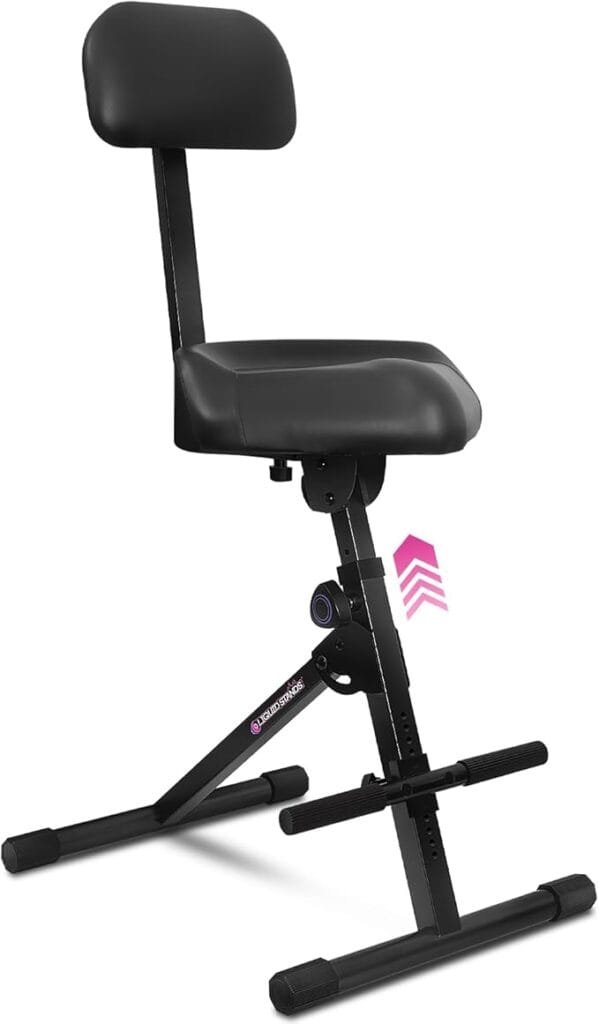
When standing
- At first, learn your songs the best you can in a calm position, then gradually practice moving around as you would on a gig
- If you are also a vocalist, adjust your microphone stand’s height
- Adjust your strap so you can see and reach the fretboard and move freely
More tips from a pro
- I like to use a higher guitar position with my strap when sitting for better fretboard access and guitar angle. My acoustic guitar doesn’t rest on my thigh; it hangs almost freely
- My pedalboard position (distance and height) is different for each position:
- Standing: Pedalboard is near, bluetooth page turner is on the ground
- Sitting: Pedalboard is further, page turner is placed on its shipping box for easier access
- Singing is easier for me when standing: not guitar-related, but important
- Avoid using chairs with armrests: They get in the way
- I find it’s easier to move away from the mic for dynamics when standing
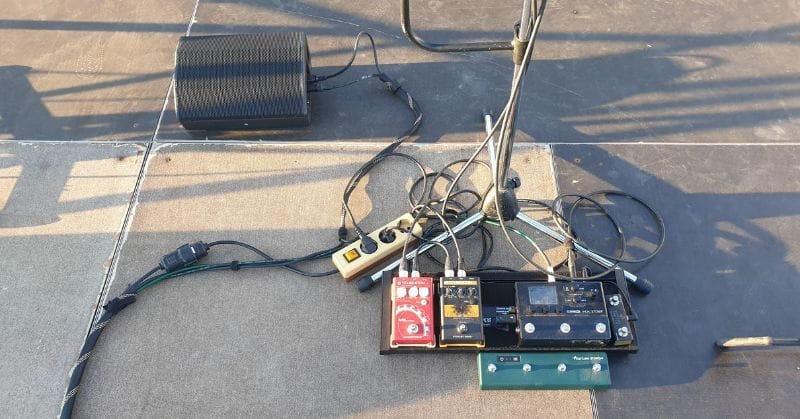
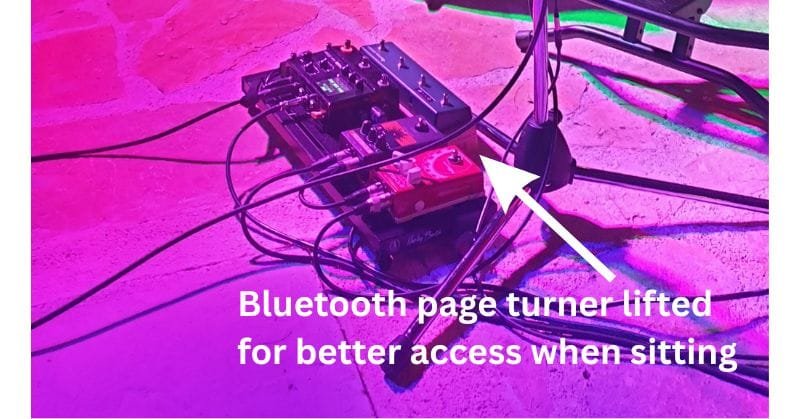
Playing with back or shoulder pain
Playing with any type of musculoskeletal disorder, or simply put, back or neck pain, is not pleasant. It doesn’t matter what the cause is; it’s there, and you have to adapt your playing so you eliminate as much pain as you can.
Many studies have reported that more musicians suffer from this problem than one would expect. Roughly, more than half of every musician has experienced some kind of music-related pain. So, how to deal with this problem?

Today, we are focusing on guitar and bass players. These guidelines can improve your playing if you experience back, neck, or shoulder pain.
- Sitting posture for playing guitar is king: The spine should be as straight as possible, whether you’re standing or sitting. When sitting, pay attention to how your guitar chair or stool is adjusted
- When you stand while playing, use a wide and padded guitar strap or a special double-shoulder guitar or bass strap.
- Choose a lightweight instrument
- Try out different chair heights and guitar strap positions until you find the best for your playing. Sometimes, only a small change can make a big difference.
- Ergonomics of your chair and instrument play a crucial role; try out different models
Final thoughts – Which is best for you?
Should you play standing or sitting down? It’s best if you know how to play in both positions, because you will become confident playing in both. We know that it is best to practice new songs and techniques in a seated position until we become familiar with the material. Then, gradually practice everything standing. That way, you will be prepared for gigs where you will be standing. Studio work is also associated with sitting.
The other big question is: Should I play standing or sitting down during a gig? Now that is a different thing. Most gigs are played in the standing position for popular music, where connection with your audience is a must. More intimate gigs can be played with guitar and bass players sitting. You could start a performance in a small club seated, but later, when the vibe gets vibrant, your band can decide to stand up; it all depends.
Bottom line for live: Play standing at big gigs, and sit at acoustic gigs, or when playing music that demands more focus on technique, like jazz or classical.

